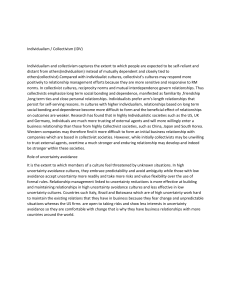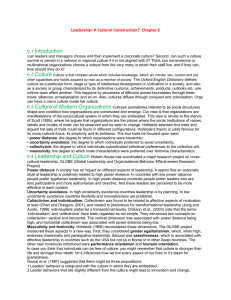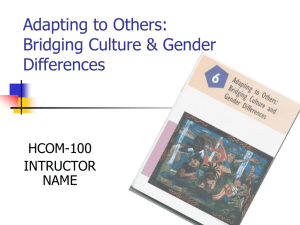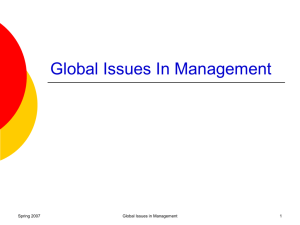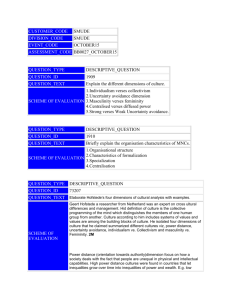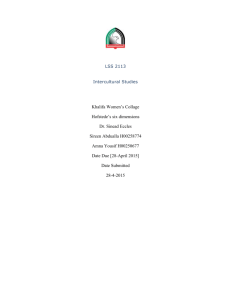Examine the role of two cultural dimensions on behavior
advertisement
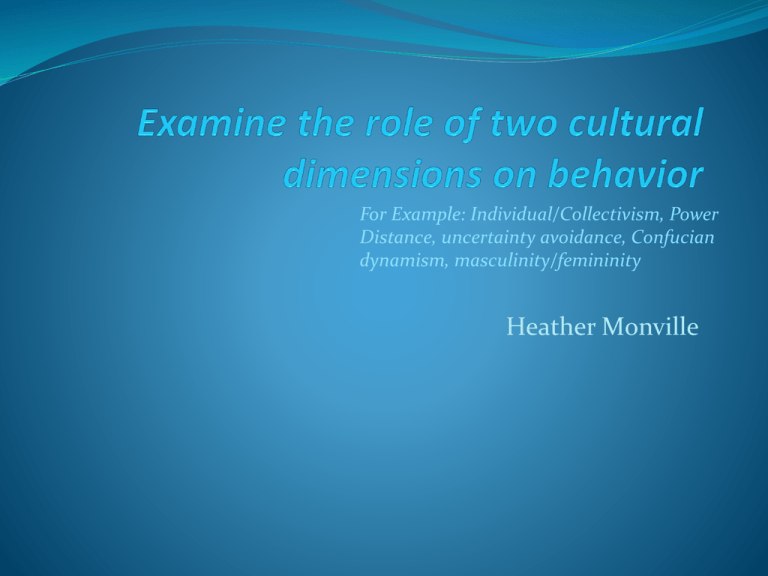
For Example: Individual/Collectivism, Power Distance, uncertainty avoidance, Confucian dynamism, masculinity/femininity Heather Monville Examine “Consider an argument or concept in a way that uncovers the assumptions and interrelationships of that issue” – Mr.Weisse Cultural Dimensions Asides from Cultural Norms, cultural dimensions is another components of Culture Dimensions-the perspectives of a culture based on values and cultural norms Hoefstede’s Classic Study (1973) Involved asking the employees of a multinational company to fill our surveys about morale in the workplace Carried out content analysis on the responses received Focused on key differences submitted by employees in different countries His research looked at 40 most represented countries Hoefstede’s Arguments Understanding cultural dimensions will help facilitate communication between cultures Different Dimensions There are four main dimensions (talked about in the book on page 126) Individualism Collectivism Uncertainty Avoidance Individualism/Collectivism Individualism Definition: The habit or principle of being independent and self-reliant. In an individualist society everyone is expected to look after himself or herself or his/her immediate family Collectivism Definition: The practice or principle of giving a group priority over each individual in it. In collectivist societies-from birth and on people are integrated into strong groups (often extended family) Markus and Kitayama (1991) Characterized a difference between United States and Japanese culture “In America, the squeaky wheel gets the grease; in Japan, the nail that stands out gets pounded”-Japanese Proverb They argue that perceiving a boundary between the individual and social environment is distinctly western in cultural orientation Uncertainty/Avoidance Uncertainty The state of being uncertain Avoidance Keeping away from or preventing from happening Deals with society’s tolerance for uncertainty and ambiguity Shows to what extent a culture programs its members to feel either uncomfortable or comfortable in unstructured situations Unstructured situations Unknown and Surprising Confucian Dynamism Bond (1988) argues that Chinese culture replaces the uncertainty-avoidance dimension with Confucian Work Dynamism Confucian Dynamism Instead of focusing on the truth, some cultures focus on virtue Example: China and other Asian Countries have a longterm orientation Value Persistence, Loyalty and Trustworthiness Hoefstede (He’s Back) Found that Finland, France, Germany and US have short-term orientation There is a value of personal steadiness and stability Focus on the future instead of the past Innovation is highly valued Warns against Ecological Fallacy When one looks at two different cultures it should not be assumed that two members from two different cultures MUST be different from one another. Or that a single member of a culture will always demonstrate dimensions of the norm of that culture Edward T. Hall Proxemic Theory (1966) Based on a cultures need for “Personal Space” The Hidden Dimension Different cultures have different perceptions of the amount of personal space that is required to be comfortable Time Consciousness Distinguished between monochronic cultures and polychronic cultures Monochronic-Cultures focus on one thing at a time Focus involved high degree of scheduling and punctuality Polychronic- Cultures where many things happen at once The focus is more on relationships and interactions
